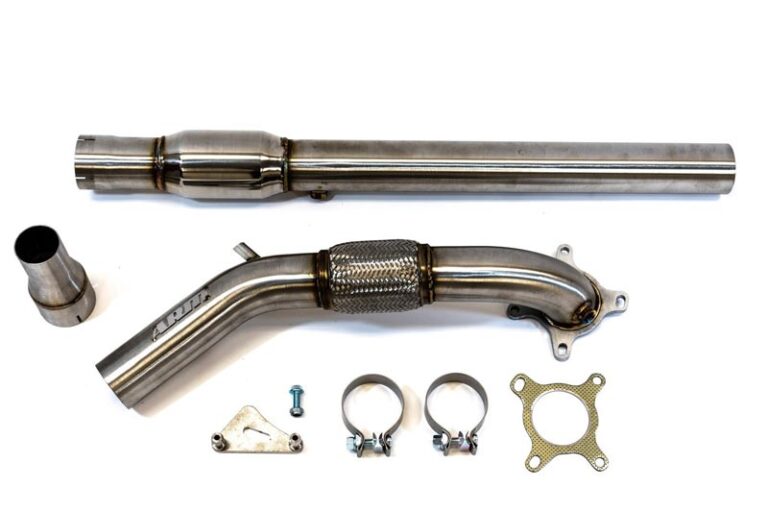Introduction to Downpipe Exhaust Systems
Rev up your engines and get ready to dive into the world of automotive performance upgrades! Today, we’re going under the hood to explore a crucial component that can make all the difference in your car’s power and sound – downpipe exhaust systems. Whether you’re a speed enthusiast looking for an extra boost on the race track or simply seeking that awe-inspiring rumble as you cruise through city streets, understanding the impact of downpipes is essential. So buckle up and join us as we unravel how these mighty pipes can revitalize your engine’s performance while unleashing an unforgettable symphony of sound. Let’s hit the road together and discover what makes downpipe exhaust systems so epic!
How Do Downpipes Affect Engine Performance?
Downpipes are an essential component of a car’s exhaust system, and they play a crucial role in determining engine performance. But how exactly do downpipes affect the overall power and efficiency of your engine? Let’s delve into the details.
Let’s talk about backpressure. Backpressure refers to the resistance that exhaust gases face as they try to exit the engine. While some level of backpressure is necessary for proper functioning, excessive backpressure can hinder performance. This is where downpipes come in.
By replacing restrictive factory downpipes with aftermarket ones, you can reduce backpressure significantly. These aftermarket downpipes are designed with larger diameters and smoother bends, allowing exhaust gases to flow more freely. As a result, your engine experiences reduced restrictions during the exhaust process, leading to improved horsepower and torque output.
In addition to reducing backpressure, upgraded downpipes also help in improving turbocharger response. The increased diameter and efficient design allow for faster evacuation of spent gases from the turbocharger housing. This leads to reduced turbo lag and quicker spool up times – giving you better throttle response and acceleration.
Choosing the right type of downpipe is crucial for optimizing engine performance. Factors such as material (stainless steel or ceramic-coated), diameter size

It’s important to note that while upgrading your downpipe can enhance engine performance, it may also affect emission levels and void manufacturer warranties in some cases. Therefore, it’s always recommended to check local regulations before making any modifications to your vehicle’s exhaust system.
To sum up: Downpipes have a significant impact on engine performance by reducing backpressure, improving turbocharger response time, enhancing throttle response and acceleration capabilities when properly chosen based on factors like material composition and diameter size.
The Importance of Backpressure in Exhaust Systems
Backpressure in exhaust systems is a topic that often sparks debate among car enthusiasts. Some argue that reducing backpressure can improve engine performance, while others believe it is necessary for optimal functioning. So what exactly is backpressure and why does it matter?
In simple terms, backpressure refers to the resistance encountered by exhaust gases as they flow through the exhaust system. This resistance is caused by various components such as mufflers, catalytic converters, and resonators.
While some amount of backpressure is necessary for maintaining proper engine function, excessive backpressure can hinder performance. When there is too much resistance in the exhaust system, it restricts the flow of gases and slows down their exit from the engine cylinders.
Reducing backpressure can lead to improved horsepower and torque because it allows the engine to expel exhaust gases more efficiently. By installing a high-flow downpipe with larger diameter piping or removing restrictive components like catalytic converters, you can achieve this reduction in backpressure.
However, it’s important to strike a balance when modifying your exhaust system. Too little backpressure can cause issues such as reduced low-end torque or even damage to certain engine components.
Finding the right level of backpressure for your specific vehicle requires careful consideration of factors such as engine size, modifications made to other parts of the intake/exhaust system, and intended use (street driving vs racing).
So next time you find yourself contemplating whether or not to modify your car’s exhaust system for better performance gains, remember that understanding and optimizing backpressure plays a crucial role in achieving those desired results!
How Downpipes Improve Horsepower and Torque
When it comes to improving engine performance, downpipe exhaust systems play a crucial role. One of the key ways they do this is by enhancing horsepower and torque. But how exactly do downpipes achieve this?
Let’s understand that the primary function of a downpipe is to channel exhaust gases from the turbocharger or manifold into the rest of the exhaust system. By replacing restrictive factory downpipes with wider and smoother ones, backpressure is reduced.
Reducing backpressure allows for better flow of exhaust gases, resulting in improved scavenging and increased efficiency. This means that more air can enter the combustion chamber during each intake stroke, leading to greater power output.
Additionally, larger diameter downpipes provide room for increased airflow capacity, enabling higher volumes of exhaust gas to exit the engine at a faster rate. This results in quicker spool-up time for turbochargers and enhanced overall performance.
It’s important to note that choosing an appropriate size for your downpipe is critical as too large a diameter may lead to decreased velocity and lower torque production at low RPMs. Strike the right balance between flow capacity and maintaining adequate velocity throughout the RPM range.
Upgrading your vehicle’s stock downpipe with a high-performance alternative can significantly improve horsepower and torque by reducing backpressure and optimizing exhaust gas flow. The result? A more powerful driving experience that enthusiasts crave!
Factors to Consider When Choosing a Downpipe
Factors to Consider When Choosing a Downpipe
When it comes to upgrading your exhaust system, choosing the right downpipe is crucial. But with so many options available, how do you know which one is best for your car? Here are some factors to consider when making this important decision.
First and foremost, you need to think about compatibility. Not all downpipes are designed to fit every make and model of car. Make sure you choose a downpipe that is specifically made for your vehicle’s year, make, and model. This will ensure proper fitment and avoid any potential issues down the road.
Next, consider the material of the downpipe. Stainless steel is a popular choice due to its durability and resistance to corrosion. However, if budget is a concern, there are also high-quality aluminized steel options available that offer good performance at a lower cost.
Another important factor to think about is diameter size. The diameter of the downpipe can impact engine performance by affecting backpressure levels. A larger diameter may provide greater airflow and potentially increase horsepower but could sacrifice torque in certain situations.
The Influence of Downpipes on Sound Quality
The Influence of Downpipes on Sound Quality
When it comes to car enthusiasts, the sound of a vehicle’s exhaust system can be just as important as its performance. And one component that plays a significant role in shaping that sound is the downpipe.
A downpipe is an essential part of an aftermarket exhaust system. It connects the turbocharger or manifold to the rest of the exhaust system and is usually larger in diameter than the stock pipe. This larger size allows for improved flow and reduced backpressure, resulting in better engine performance. But what is headers on a car?Well, it turns out that downpipes can have a significant influence on how your car sounds. The increased airflow provided by a larger downpipe means that more air can pass through the exhaust system, creating a deeper and more aggressive tone. So, if you’re looking to give your ride an intimidating growl, upgrading to a high-quality downpipe might be just what you need.
Of course, not all cars will benefit from this modification in terms of sound quality alone. Factors such as engine type and size will also contribute to how your vehicle sounds with an upgraded downpipe installed. Additionally, other components like mufflers and resonators play their part in shaping the final tone emitted by your car’s exhaust.
While improving engine performance may be the primary goal when installing a new downpipe exhaust system, there’s no denying its influence on sound quality as well. So if you want to unleash a beastly roar every time you hit the gas pedal or simply add some extra rumble to your daily commute, consider investing in a high-quality downpipe suitable for your vehicle model!
Conclusion
The Impact of Downpipe Exhaust Systems on Engine Power and Sound: Conclusion
In the world of automotive enthusiasts, the downpipe exhaust system is considered a crucial component for enhancing both engine performance and sound quality. By reducing backpressure in the exhaust system, downpipes allow for smoother airflow and improve horsepower and torque.
When choosing a downpipe, it’s important to consider factors such as material quality, diameter size, and compatibility with your vehicle. Stainless steel is often favored for its durability and resistance to corrosion. Additionally, selecting the appropriate diameter ensures optimal flow velocity without sacrificing low-end torque.

0 Comments